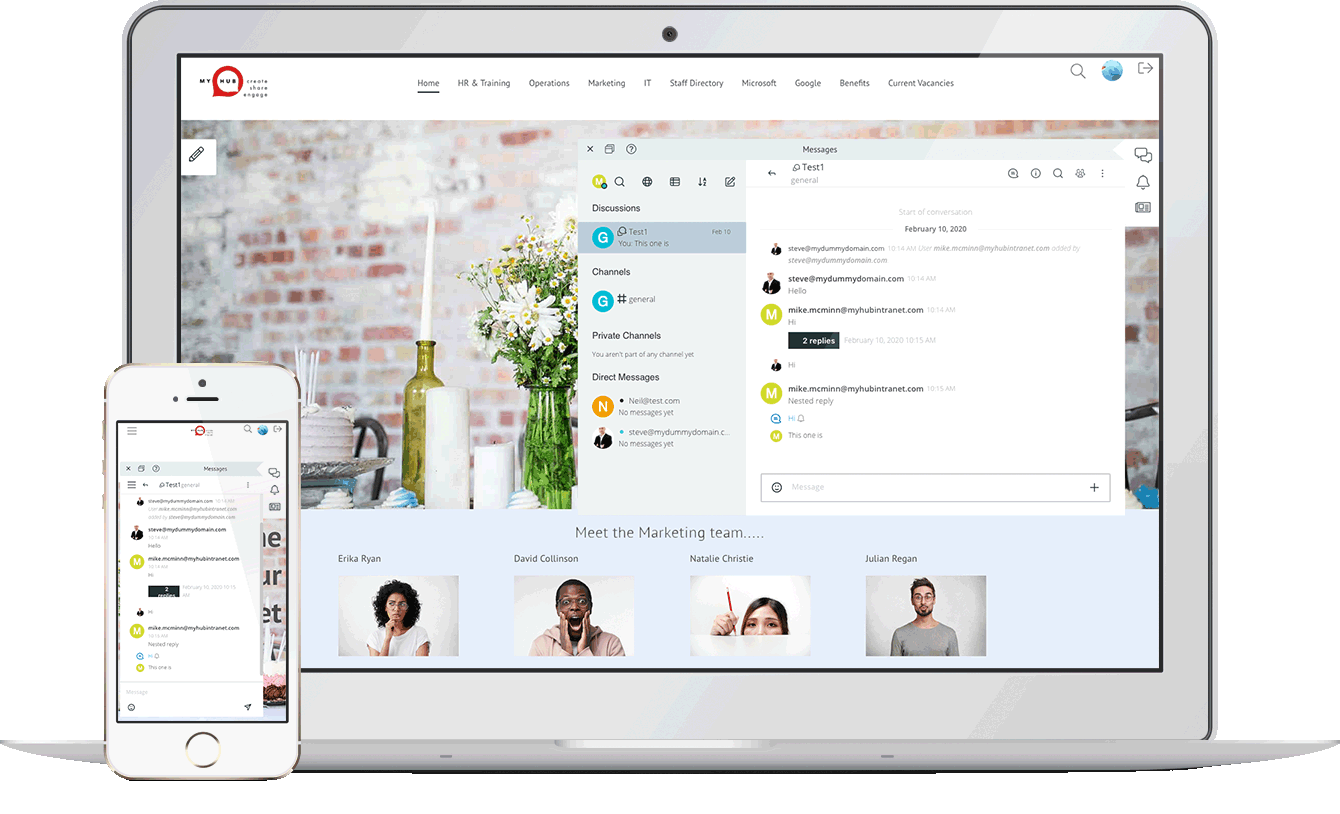Team Collaboration
How To Help Staff Connect, Encourage Ideas, And Move Work Forward
Share. Communicate. Innovate

Team collaboration is a prominent trait among today’s winning organizations. Done right, collaboration aids better decision-making, innovative thinking and improved productivity. Staff are happier, performance is boosted, and there’s less risk of error.
But many organizations have yet to figure out how to help colleagues work better together to achieve a common goal.
The good news is that there are tools and techniques that have proven to nurture a strong collaborative culture within the workplace.
Here, we shed light on the causes of poor collaboration, tips for improvement, and collaboration software that enables co-workers to share ideas and improve internal communications.
What Is Team Collaboration?

The definition of team collaboration is when two or more people work together to achieve a common goal. This is done through idea sharing, planning and executing in unison. In contrast to working on one’s own, team collaboration is regarded as a more productive way to get work done, and carries less risk.
Tackling a major project – such as a new product launch or the introduction of a new internal process – usually requires a teamwork approach. This entails bringing together a group of employees to allocate and complete tasks, within a set timeframe.
These days, with technology overcoming geographical barriers, virtual teams are popular. Companies are now appointing the best people for a project – regardless of their work location – to form part of a team and collaborate. This development has created new opportunities for businesses to innovate – but is not without its challenges.
Why Is Team Collaboration Critical In The 21st Century?

Never before has the workplace been so diverse. For the first time in history, five generations are working side-by-side. Each employee has a unique perspective. Their opinions are formed by their own personal experiences. And they have different communication styles – some prefer face-to-face, others the written word.
Such differences are a lot to manage, particularly when complex, project-based decisions must be made.
How a team interacts with each other will influence the final outcome. Communication, knowledge transfer and equal respect for each team member are essential for a high-performing team.
Younger generations joining the workforce are eager to further develop the collaborative skills they’ve learnt during education. They place place greater support on social tools for collaboration than their older colleagues (49 per cent millennials vs 31 per cent baby boomers). And considering that 46 per cent of 2020’s workforce are millennials (compared with 36 per cent six years ago), employers must act upon this growing generation’s preference for building team dynamics.
Furthermore, around 75% of employees now rate teamwork and collaboration as crucial to their performance.
Reasons For Poor Team Collaboration
It’s a common scenario when a collection of people come together to solve a problem, cross-functionally. There may be representatives in the room from IT, Sales, Product and Finance.
When collaboration fails, it’s often because these individuals partially listen to others points-of-view, but do not fully seek to understand what they were actually saying.
Each representative remains in their own paradigm rather than genuinely taking on board and seeking a solution based on other perspectives.
To counter this, effective collaboration requires recognition of diversity; that each individual has their own thought process and purpose. This requires greater understanding of the team individuals, and the concerns they may be feeling.
These could include the following:
- Skepticism about the success of the project i.e.‘doomed to fail’
- Uncertainty around who does what in the team, and where tasks and responsibilities sit
- Misinterpretation or miscommunication: wrongly assuming all staff have the same understanding
- Lack of direction, KPIs and milestones set out from the start
- Conflicting priorities: failing to appreciate an employee’s current workload before adding more
- Forcing staff to communicate in ways that may be uncomfortable for them i.e. introverted employees making team presentations
How To Improve Team Collaboration
Successful team collaboration is hard work. With so much to consider – silos, company culture, staff at different locations, leadership styles – good team collaboration doesn’t happen by accident.
Furthermore, Harvard Business Review has exposed an interesting paradox at play, based on its research into team behavior:
“Although teams that are large, virtual, diverse, and composed of highly educated specialists are increasingly crucial with challenging projects, those same four characteristics make it hard for teams to get anything done.
“To put it another way, the qualities required for success are the same qualities that undermine success. Members of complex teams are less likely to share knowledge freely, to learn from one another, to shift workloads flexibly to break up unexpected bottlenecks, to help one another complete jobs and meet deadlines, and to share resources.”
It also found that the higher the educational level of the team member, the more challenging collaboration appears for them.
But there are some best practices for building effective collaboration strategies, as follows:
Define And Repeatedly Communicate The Team’s Goals
This is the first step to bringing together a group of people. Goals should be reiterated at the start of daily huddles, referred to when key decisions are underway, and repeated across all communication channels (your intranet, for example).
Promote Open Communication Particularly When Faced With A Roadblock
This is where technology has become a game-changer. Instead of waiting for the next round-table meeting to overcome a roadblock, intranet tools such as forums, instant messaging, and shared files allow members of the same team to work through a problem collaboratively at pace.
Create Structure Within Meetings And Give Staff Time To Prepare
WIP (work-in-progress) meetings are an important part of effective project management. Ahead of each meeting, share agenda items, action lists and related reading material with all members of the team so there are no frustrating delays when teams meet.
Encourage Creativity And Free-thinking: All Ideas To Be Respected
Brainstorming sessions can be fun and fruitful. Team leaders must give advance warning though so staff can do their own research. And if you’re the manager, resist the urge to direct and jump in immediately with your ideas, as staff may feel obliged to follow.
Log Important Decisions And Their Backstory
Avoid the “he said/she said” nature of spontaneous conversations; make sure ideas are contextually documented in a central space, accessible for all, and not lost in the moment.
Invest in Collaboration Tools
Team collaboration tools have shown the way here. Employees can set up team channels where decisions can be made in real-time. Slack, the popular chat tool, has been joined by a host of other instant messaging tools, virtually eliminating the need for traditional email. Video conferencing, in the wake of Covid-19, has become the default meeting format. And forums are another effective channel for effective team collaboration.
Check For Understanding
Nodding heads does not necessarily mean agreement and understanding. Many co-workers won’t like to admit they don’t understand something. Reiterate major decisions – during and after meetings – providing clarity and an opportunity for others to ask further questions. Engage in two-way communication with all members when possible.
Create Ways For Less Outspoken Team Members To Contribute Ideas
Not everyone has public speaking skills. Shy people will not feel comfortable sharing their idea in a room full of colleagues, but may happily submit an idea via a forum or chat channel. Make it known that individual thinking is unique and valued, and that every team member should be able to communicate with equality and authority.
Share Experience, Knowledge And Resources
Use an intranet to capture treasured insights – physically and virtually with file-sharing software. This will save mistakes being repeated, and knowledge walking out the door when someone leaves. Don’t leave this to chance: embed a process for eliciting and storing this valuable intelligence as part of your regular WIP meetings. Add tags to meeting notes that can be searched for later on.
Acknowledge And Celebrate Individual And Team Success
Highlight individual qualities and the special skills that each team member brings to the table. Go big when a milestone or key task has been ticked off with a team building celebration event. This boosts morale and makes people feel valued.
Appoint Task And Relationship-Oriented Leaders
HBR research found that the most productive and innovative teams had leaders who could outline clear goals and responsibilities and easily switch to relationship-building mode i.e. smoothing out internal tensions.
Limit Group Sizes
Not always possible – particularly if you’re about to organize the next Olympics – but aim to keep teams small enough so that staff get to know (and respect) each other, and ideas exchange freely. Big teams tend to be more vulnerable to tunnel vision, or the ‘squeakiest wheel wins’.
❝
Collaborative teams are 5 x higher performing as they feel motivated towards a common goal
Source: i4cp
Team Collaboration Trends
Team Collaboration tools are evolving to suit the changing needs of businesses today.
Flexibility, scalability, and compatibility with existing systems increasingly matter. Because of this, enterprise players such as Cisco, Slack and Microsoft have no choice but to integrate with each other.
Some other noticeable trends in team collaboration include:
Artificial Intelligence
Machine learning tools and bots can help an entire team improve the way they collaborate by making it easier to find information instantly. They can also offer things like real-time translation and transcribing during video conferencing meetings.
Unique Experiences
As more technology vendors come to the integration and interoperability party, open-source platforms with the help of APIs are enabling employers to build their own collaboration experience, just right for their internal culture.
Love Of Video
This format’s popularity continues to rise, but so do expectations around its performance. With remote teams the new normal, businesses are relying more on video conferencing, which must be reliable, secure and consistent.
Team Collaboration Software
Creating a workplace using team collaboration software is a practical move that can really transform how you and your colleagues collaborate.
MyHub’s cloud-based intranet is designed specifically for organizations in search of an affordable and adaptable collaboration solution. It’s fully scalable, designed to support your company’s growth. And fully customizable, to meet your exact needs.
Combining a company internal newsfeed, instant messaging and secure cloud storage, MyHub is the perfect choice for your important projects-in-progress.

Whether you’re an IT pro or completely non-technical, MyHub’s cloud-hosted solution offers all the features and functionality you’ll ever need.
We’ve made it so that it’s super simple to set-up (no coding skills or IT experience required) – and is enjoyable to use!
Using simple drag-and-drop functionality, you can create a professional space for your team to start collaborating in minutes! Being cloud-hosted also means you’re future-proofing your investment: you get to benefit from our latest new features and enhancements as soon as they’re released.
Useful Team Collaboration Resources
How To Create An Intranet: A Step By Step Beginner’s Guide
Launching an intranet can feel overwhelming—especially when the options seem technical and the stakes are high. This guide starts by demystifying what an intranet is: a secure internal network where employees collaborate, share resources and communicate effectively. It then explores the main types of intranet solutions—custom-built, off-the-shelf, or cloud-hosted—so organisations can choose an option based on their needs, budget and technical capacity.
The next section drills into the step-by-step process. It begins with assembling the right project team (cross-department representation and leadership support). Then it emphasises defining clear goals and conducting a needs analysis (what problems you want the intranet to solve). Afterwards comes selecting the software solution, designing the site architecture and content strategy, and building the intranet with branding and usability in mind. The guide offers practical design tips like the “six-six rule” (max six pages per section, six items per page) and emphasises mobile-responsiveness and simple navigation.
The final part covers launch and long-term success: pilot testing with a subset of employees, training users and champions, creating buzz around the go-live, and establishing governance, feedback loops and continuous improvement to keep the intranet relevant. The message is clear: the intranet isn’t just a project you check off—it’s a lasting part of your digital workplace that evolves with your business.
The Complete Intranet Design Guide: All You Need To Know
In this guide, MyHub outlines a structured approach to designing an intranet that truly works for users — not just IT. The process begins with defining the purpose: who the intranet serves, what problems it solves, and how success will be measured. Without this foundation, the design risks being misaligned or under-used.
Next the guide walks through key design components: branding (logo, colours, tone), site architecture (navigation, page hierarchy, discoverability), content strategy (what will live on the intranet, how often it’s updated, who owns it), and user experience (mobile access, intuitive layouts, search). Each step is explained in actionable terms, making the technical feel accessible to non-IT stakeholders.
Finally, the guide emphasises launch and adoption: creating a phased rollout plan, training champions, gathering feedback, measuring usage metrics, and maintaining momentum after go-live. The idea is that a successful intranet isn’t built once and forgotten — it evolves through use, stakeholder input, and continuous improvement.
81 Inspirational Employee Engagement Quotes
This article presents a collection of 81 carefully selected quotes about employee engagement, drawn from leadership figures, business thinkers, and motivational voices. It begins by explaining that while quotes may seem simple, their power lies in context—used thoughtfully they can underscore culture, values, and recognition within the workplace.
The piece is structured into themed sections — for example: quotes on the importance of engagement, for managers, for retention, and for recognition. Each section offers sample quotes that organisations can embed into intranet pages, newsfeeds, celebration boards or team-chat channels to reinforce engagement. It also includes guidance on how not to over-use quotes: the risk being that too many or inappropriate use can dilute sincerity.
Finally, the article emphasises that quotes are a tool — not a substitute for action. They work best when paired with tangible engagement strategies: clear communication, recognition, purpose-driven work, feedback systems and intranet features that support visibility and belonging. In other words, use the quotes to amplify culture, but keep engagement real.
Best Company Intranet Names: Ideas and Examples
Choosing the right name for your intranet is more than just a branding exercise; it’s about creating an identity that resonates with your team and reflects your company’s values. The MyHub article emphasizes the importance of a thoughtful intranet name, explaining that it can inspire, motivate, and engage users, while also conveying your brand’s vision and values. A well-chosen name humanizes the intranet and helps distinguish it from other company systems.
The blog provides a curated list of ten creative intranet names to spark inspiration. These include “Work-e-pedia,” “Exchange,” “The Grid,” “Pulse,” “Elvis,” “The Hub,” “Gateway,” “Insite,” “The Forum,” and “Planet.” Each name is accompanied by a brief explanation of its potential appeal and relevance, offering a diverse range of options to suit various organizational cultures and objectives.
Beyond the list, the article offers practical advice on how to approach the naming process. It suggests considering your intranet’s goals, your company’s culture, and how employees will use the platform. The blog also recommends involving staff in the naming process to foster a sense of ownership and engagement, ensuring the chosen name resonates with the entire organization.
Recruitment Quote: 34 Inspiring Quotes For HR Professionals
In recruitment, the right words carry weight—whether you’re attracting talent, inspiring your HR team, or communicating your employer brand. A “recruitment quote” is more than a nice line; it can encapsulate culture, values, and aspirations in a memorable, shareable way.
The blog likely curates a selection of impactful recruitment quotes—perhaps from business leaders, HR experts, or famous thinkers—and ties them back to recruiting challenges like attracting the right candidates, remaining authentic in messaging, overcoming hiring biases, or promoting long-term fit. Each quote is probably framed with context: why it matters, where it can be used (job ads, interview decks, team meetings), and how it can shift mindset.
Beyond the quotes themselves, the article may offer tips on how to use them well: integrate into job postings, internal training, social media, or onboarding materials; avoid clichés; match quotes to your brand voice; and rotate them to keep them fresh. Quotes work best when they resonate authentically and reinforce your unique recruitment values.
Thank You Notes For Coworkers: 50 Heartfelt Messages For Work Colleagues
A well-timed thank-you note can light up a colleague’s day—and strengthen workplace relationships in meaningful ways. The article begins by exploring why even small expressions of gratitude matter: they foster camaraderie, improve morale, and support a culture of appreciation. Though moments can slip by, having a bank of ideas on hand makes recognition easier to act on.
To help, MyHub curated 50 thank-you messages that span various scenarios—general gratitude, departing colleagues, covering for absence, bosses, humorously light notes, and more. The messages are adaptable across email, cards, chat apps, or intranet shout-outs, and are organized by the context in which you want to thank someone.
Beyond the list, the article emphasizes the broader impact of appreciation on organizational performance. It cites research showing that companies with strong cultures of recognition experience higher growth, and further argues that appreciation isn’t just a perk—it’s a strategic advantage.






